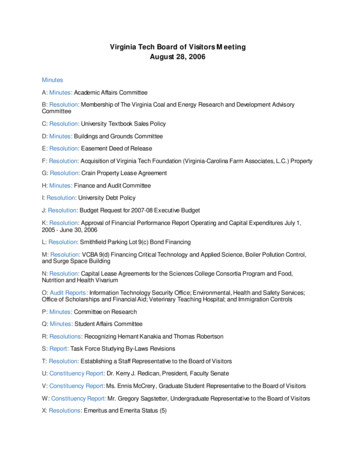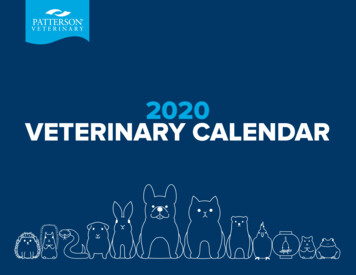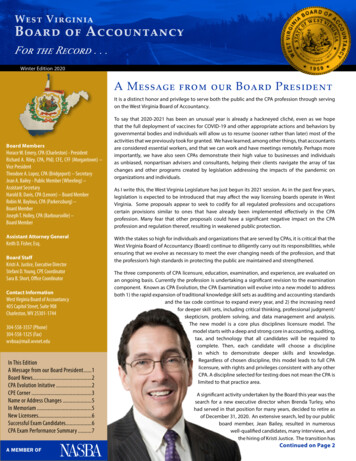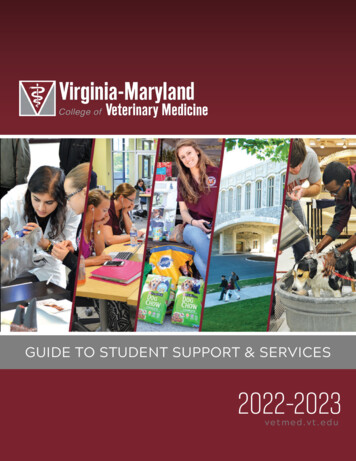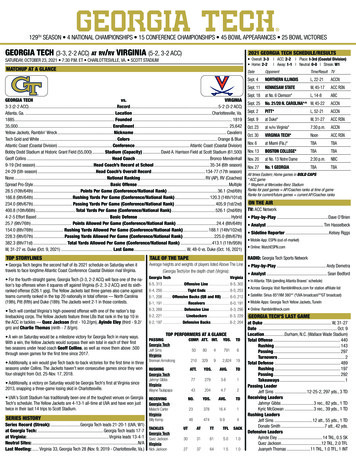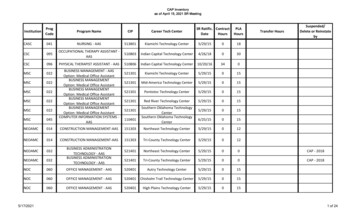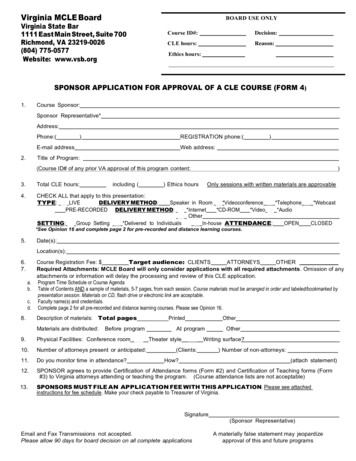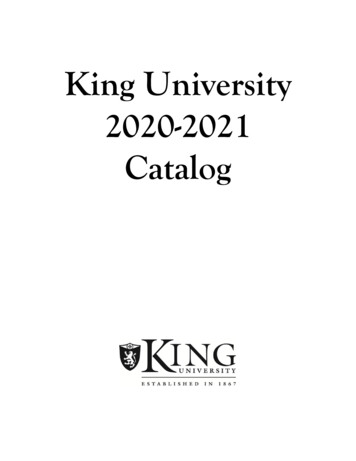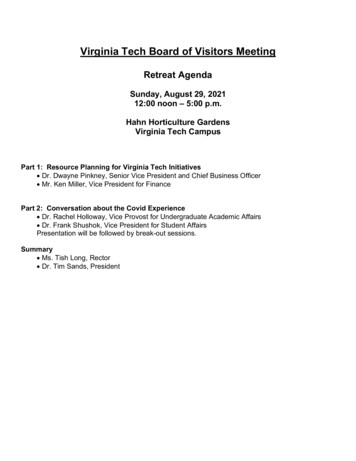
Transcription
Virginia Tech Board of Visitors MeetingRetreat AgendaSunday, August 29, 202112:00 noon – 5:00 p.m.Hahn Horticulture GardensVirginia Tech CampusPart 1: Resource Planning for Virginia Tech Initiatives Dr. Dwayne Pinkney, Senior Vice President and Chief Business Officer Mr. Ken Miller, Vice President for FinancePart 2: Conversation about the Covid Experience Dr. Rachel Holloway, Vice Provost for Undergraduate Academic Affairs Dr. Frank Shushok, Vice President for Student AffairsPresentation will be followed by break-out sessions.Summary Ms. Tish Long, Rector Dr. Tim Sands, President
M u l t i -Ye a r O p e r a t i n g R e s o u r c eDevelopment PlanningDWAYN E P IN KNEY, S E NIOR VIC E P R E SIDENT AN D C B OKE N M IL L E R , VIC E P R E SIDENT F OR F IN AN CEAUGUST 29, 2021
Resource Overview & Trends
Public & Private Resources2021-22 Budget in Millions208 E&GIn-StateState T&MF 214.7 256.2Out-of- Program/StateCourseSelfT&MFFeesGenerated 309.6 38.6 60.6Total 879.8229 E&G79.216.495.6Student Financial Auxiliary EnterprisesSponsored ProgramsAll Other Programs (UMA)Subtotal Public Resources 337.2256.2309.6797.3Virginia Tech FoundationOther University-Related EntitiesTotal 337.2% of total17%3Private193.4 256.213% 309.616% 797.341%1,739.0193.4 *29.429.4 * 222.8 1,961.8*estimated11%
Agency 208 Educational & General2021-22 Revenue SourcesIn-StateTuition &MF, 29.1%Out-of-StateTuition &MF,35.2%StateGeneralFund, 24.4%Revenue ComponentsOut-of-State Tuition & MFIn-State Tuition & MFState General FundProgram/Course FeesAll Other E&G IncomeContinuing EducationProgram/Course Total 208 E&G RevenueFees, 4.4%All Other E&GIncome, 5.6%ContinuingEducation, 1.3% %24.4%4.4%5.6%1.3%100%
Higher Education Policy Constructs Commonwealth policy intends to subsidize residentstudents. Due to economic volatility and growth in other state budget driverslike Medicaid, the Commonwealth’s ability to subsidize Virginiaresident undergraduate education is inconsistent over time. Non-resident students must pay at least 100% of theaverage cost of education. Historic limitation on out-of-state enrollment. Modified to provide additional flexibility in 2020.
Assessment of Current Funding
Resources per In-state Student Vi r g i n ia s u b s i d i z e s c o s t o f Vi r g i n ia R e s i d e n t U n d e r g r a d u a t e e d u c a t i o n State support has fallen, shifting burden to students/families In the current year, the university has 1,674 LESS per resident student than in 2000-01.General Fund and Tuition and E&G Fees per In-State UndergraduateHEPI Inflation Adjusted to 2000 14,000 12,000 10,000 8,000 6,000 4,000 2,000 0Inflation Adjusted General Fund per ResidentInflation Adjusted T&F per Resident
VT Value A m o n g t h e t o p 2 0 L a n d G r a n t i n s t i t u t i o n s i n t h e n a t i o n , Vi r g i n ia Te c h ’ s c o s t p e rd e g r e e y e a r r a n k e d a m o n g t h e lo w e s t a t 1 8 , 2 1 4 o r 7 2 , 8 5 6 f o r a f o u r- y e a rba c h e lo r ’ s d e g r e e .Cost Per Degree Year - 2019Virginia DoctoralTop 20 Land-Grants40000 40,000 36,237 35,00035000 30,000 25,000 20,000 15,000 10,000 5,000 -30000 18,214 25,40925000 23,90220000 18,214 17,781 17,614VTGMUODU150001000050000UVAW&MVCU
VT Administrative EfficiencyAdministrative Spending per Dollar of Instructional Spending FY20190.14VA Tech0.19SCHEV (n 25)Public R1 (n 92)0.19Virginia R1 (n 3)0.200.000.020.040.060.080.100.120.140.160.180.20
Tuition & Fee EfficiencyVirginia Tech: 5th lowest total cost of VADoctorals Lowest 5-year cumulative increaseamong VA Public Doctorals Slower than inflation Froze tuition at the onset of theCOVID-19 pandemic (FY20) Leverages cost mitigation withincreased financial aid investmentsto expand affordability and accessIn-state Undergraduate Total CostVA Public Doctoral Institutions 40,000 35,000 3,571 30,000 2,726 2,832 25,000 2,735 33,843 2,131 2,211 20,000 27,060 23,811 23,014 15,000 10,000William and Mary(Freshmen)University ofVirginia (FirstYear)VirginiaCommonwealthUniversity2017-18 Total CostGeorge MasonUniversityFY18-FY22 Increase 21,920Virginia Tech 20,472Old DominionUniversity
Virginia Tech UndergraduateTuition and E&G FeesIn the last 5 years: CPI has increased 12.7% Tuition has increased 9%2.0%1.0%0.0%0.0%0.0%In FY20, state funding was provided to moderate tuition. In FY21, tuition was held level to be sensitive to the financial impacts of the pandemic.
Environment
Financial Management Strategy Goal is to maximize the achievement of the university’sstrategic plan Based on understanding of cost drivers, universitydevelops resource plan. How can existing resources be maximized? Seek new resources General Fund State (can be inconsistent) Self-generated: grants, private, other Enrollment management Last resort: Tuition and Fee increase
Cost Drivers
2 Cost PoolsInflationInitiatives
Inflationary Cost Drivers1.Compensation Maintain market position (no progress) Fringe benefit rate increases2. Unavoidable Cost increases Central fixed costs, contracts, subscriptions 155 Million*Estimate over Six-Years3. Maintaining Student financial aid purchasing powerTotality of Resources must increase with inflation Program reductions results if total resources do not increase with inflation. Must be funded before initiatives* Future inflation is unknown, 3% estimate for discussion purposes computed on 208 E&G 800M budget.
Initiatives Envisioned over next 6 years
Initiatives Envisioned over next 6 years
Planning Example: Need for Student Financial Aid 12,000Average Amount of Institutional Grant Aid Awarded to Full Time First TimeUndergraduates (2018-19) 10,503 10,000 8,000 7,619 7,977 6,000 5,405 4,000 2,000 0SCHEV PeersVirginia PublicsTop 20 Land GrantsVirginia Tech
Planning Example: Student Financial Aid Net price is the costremaining after financialaid has been applied tothe total cost ofattendance (tuition, fees,room and board, andother expenses). The university remainscompetitive with “sticker”price, but has anopportunity to enhancethe “net” pricecompetitiveness forresident students fromlow- to middle-incomefamilies.
Planning Example: Innovation Campus Proforma
Quantification of Costs over 6 YearsInitiativesInflation 155M 176M
Recognizing Resource RealitiesInflation 155MInitiatives 176M 52MUnderstanding that a bold visioncan exceed resource capacity,restraint is needed.1% placeholder to jump start thediscussion.Can be increased/decreased toaccelerate/slow the rate of progress
Operating Funding Need ProposedInflationInitiatives 155M 52M /-Funding Need formula: INFLATION 1% /- per year
Operating Funding Need in MillionsDoes not include ContinuingEducation, Vet hospital
Decision Framework
Decision Framework Must maintain a structurally balanced budget Resources are finite State has limits Natural limits on the total cost of education (tuition& fees) Opportunistic about resources Alternative funding sought before seeking a tuitionrate increase Federal, state, private, grant, self-generated,existing, enrollment, etc.
Decision Frame Work All needs compete for resources For example, to have more in auxiliary fees requires a lowertuition rate and vice versa All needs are prioritized E&G compete with auxiliary enterprise needs, etc The university budget process seeks to optimize the entiresystem to maximize the achievement of the university’sstrategic plan (of which some objectives are competing) Some costs are unavoidable (inflation, unfunded mandatesrelated to compliance, fringe benefit rates established by thestate, minimum /competitive wage rates, etc.)
Resource Opportunities
Resource OpportunitiesReallocations Limited opportunity in a lean/efficient institution Recall 3%/5% college/other base budget reductionin FY21 Challenge, new programs are often more expensivethan existing programs. Obligations to existing students & faculty. Accreditation teach out requirements, tenure, etc Since E&G costs are 80% personnel, reallocationslead to personnel reduction While reallocations and program changes are done,continual reductions are not sustainable
Resource OpportunitiesGeneral Fund State funds share of state actions (salary or fringe rateincrease)39% for 208 E&G budget Significant state support for operating initiatives ispossible in some years but unlikely in every year. GF is 24% of the E&G budget, for a GF increase tosupplant the need for a tuition increase would requireGF to increase at 4 times GF inflation 1% (thus coverthe NGF share of i 1%) Research initiatives are prime candidates for targetedstate requests.
Resource OpportunitiesEnrollment growth VT has strong demand as demonstrated byincreasing applications for admission However, need to ensure adequate capacity forsuccess Growth brings incremental cost of educatingadditional students Scale also offers some efficiencies and benefits(e.g. leveraging central administrative systems,academic programs critical mass)
Resource OpportunitiesEnrollment Mix VT has strong demand outside Virginia State provided new flexibility to support expectedstate workforce needs. State obligation to maintain fall 2018 in-state UG levels andnot increase nonresident proportion more than 1% per year. Nonresident Undergraduate as of Fall 2020:VT 28.6%, UVA 30.5%, W&M 32.9%, VMI 37%Ohio St 38%, Penn St 42%, Iowa St 44%, Purdue 48.6% Demand is uneven Competition in the nonresident market is expected tocontinue to increase
Resource AlternativesBaseline ModelGeneral Fund, Tuition, and Fees move at inflation 1%Alternative Models1. Net from Enrollment growth2. Net from stronger enrollment Mix3. Combination of Enrollment and Mix4. State support (above inflationary rate)State Decision5. State support, Enrollment, & Mix6. Private & Endowment for Targeted InitiativesDonor Decision
Resource AlternativesAlternative models could result in1. Lower tuition & fee rates than would otherwise occur.Virginia residents obtain increasing value without havingto fund the enhancements (initiatives).2. Better alignment with other goalsNeed for scaleVirginia workforce demands3. Rate of progress on strategic goals is a choice.Can be modulated.
Resource AlternativesObjectiveAssuming 3% inflation 1% initiatives, achieve a 4% increaseon an 800M base ( 32M).Resource AlternativesAlternativeTuition & MF RateGeneral FundEnrollmentResidency MixIncrement1%1%500 students1% Increase (M)5.652.12.85.3
Resource Alternatives
Resource Alternatives
Resource Alternatives
Discussion
. Lopez,S.L., Pendrotti, J.T. & Snyder, C.J. (2018). Positive psychology: The scientific and practical explorations of human strengths (4th Ed.).
A Student-Centered CultureProvides a Relationship-RichEnvironment1. Every student must experience genuinewelcome and deep care.2. Every student must develop a web ofsignificant relationships.3. Every student must be inspired to learn.4. Every student must explore questions ofmeaning and purpose.
LessonsLearned
Virtual strategies providednew opportunities forconnection Student Engagement EventsAcademic AdvisingEmployer Information SessionsTeaching and Learning Innovation
“While this year has looked quite different in terms of teaching andlearning, you have never failed to bring positive energy to our class.Your one on one feedback on projects has been not only helpful,but has also inspired us to continue to do good work. We appreciateyour flexibility this semester with how we could interpret promptsdifferently and twist each project into something we loved. Thankyou for being conscious of how hard it is to sit in front of a computereveryday and making sure to get us out and about. Hopefully wecan see you in person in the fall!”
“With classes being online this year, the “classroom” experiencehas been lacking, but not for your class! Your class was alwaysinteresting and I felt really involved with clicker questions andgroup application days. You have really made an impact on me as abio major, and all of the scientific papers we have worked throughhave made me interested in research, which is something I had notreally considered before. Thank you for being such an amazingprofessor!”
The virtual environment createdsignificant challenges for somelearning environments Internships and Co-opsStudy AbroadField ExperiencesArts Performance
In general, asVirginia Techundergraduateeducation movedinto an onlineenvironment,senior surveyrespondents’evaluation of thedistance-learningcourses decreased.
The pandemic also producedclear signs of stress in ourcommunity. Mental health and wellnessAcademic integrity
Need for greater care due to the pandemic
Increase in undergraduate academic integrity violationreports.
I felt completely alone and depressed during this last schoolyear. My days were spent isolated in a small apartmentbedroom with very little interaction with other students,especially those in my major. A week before the due date of theassignment that caused my infraction, I was a total mess. Isimply should have not turned in the assignment but, instead,looked to the internet for guidance.
Virginia Tech is acaring community.
Online LearningB O A R D O F V IS ITO R S R E TR E A TAUGUST 29, 2021
Exclusively online--when a program or course aswell as student support is fully online.SharedTerminologyHybrid program--students take some but not allcourses online.Hybrid course—both face-to-face and onlineinstruction takes place in a course.Exclusively face-to-face—programs or coursescompleted without online learning
§EnrollmentGrowth inOnline Learning§Growth at the undergraduatelevel is in multi-modaldelivery, the combination ofin-person and online learning.Online learning has seen thegreatest growth in exclusivelyonline graduate degrees.
GeneralEducationMinor andElectivesThe Multi-ModalUndergraduateDegreeStudents complete acombination of faceto-face, hybrid, andexclusively onlinecourses to build aflexible andpersonalized degree.BridgeExperiencesMajor
Growth in online learning enrollments at the graduate level is in exclusivelyonline degrees.Courtesy of EABInstitutions With More Than 2,500 Exclusively Online1 Graduate Enrollments, Fall 2018Total Exclusively Online Graduate Enrollments and Percent From Out-of-StatePercent of Exclusively Online Graduate Students from Out-of-StateUniversityof WaldenUniversity19,9301 00 %41,54526,415GeorgiaTech.30,18317,839Chamberlain U.7 5%Bubble size showstotal online graduatestudents from out-ofstateJohnsHopkins U.Ball StateU.25,052SouthernNew HampshireUniversityLibertyUniversity27,812Grand CanyonUniversity5 0%1 in 5CentralMichigan U.2 5%Online graduate students attend theseseven institutionsU. Maryland GlobalCampusMore outof-stateU. Texas atArlingtonMore onlineenrollments0%0K1) Recorded by IPEDS as exclusively distance enrollments.1 0K2 0K3 0KTotal Online Graduate Students4 0K5 0KSource: EAB analysis of distance enrollment data fromIPEDS Fall Enrollment Surveys 2012-18.5
The exclusivelyonlineundergraduatedegree.Serves students with priorcourse credit and propels themto new opportunities.
Students complete anassociate degree throughVCCS online.Transfer to Virginia Tech tofinish the undergraduate degreeonline.Transition seamlesslyinto the online Master ofInformation Technology.
vestment.Graphic courtesy of EAB.
University of Virginia (First Year) Virginia Commonwealth University. George Mason University. Virginia Tech. Old Dominion University. In -state Undergraduate Total Cost. VA Public Doctoral Institutions . 2017-18 Total Cost. FY18-FY22 Increase
